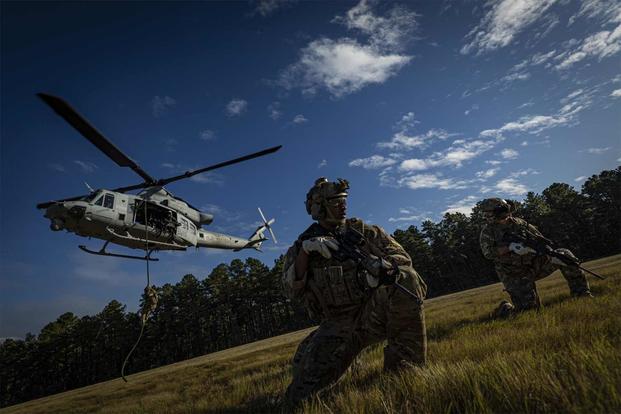The U.S. Air Force has created a new single-entry program for recruits interested in special warfare careers to earlier identify candidates who may have the aptitude and skills to become a battlefield airman.
Beginning in April, selected special warfare candidates within basic military training will enter Air Education and Training Command's new Special Warfare Operator Enlistment Vectoring program, or SWOE-V, the service announced Feb. 21.
That means recruits on the path to become combat controllers, pararescue, Tactical Air Control Party (TACP), or special reconnaissance airmen will converge under the 9T500 Air Force Specialty Code (AFSC). This is a change from assigning airmen to specialties before they can make a competent decision about their career choice, AETC officials said in a release.
"This change allows candidates to make a more informed career decision, prior to being vectored, after months of education, training, development and mentorship, to see what career field might be the best fit for them," said Lt. Col. Joseph Lopez, AETC's special warfare division chief.
Related: SpecOps Recruiting Squadron Helps Air Force Combat 'Runaway Attrition'
"The program also enhances the Air Force's ability to assign airmen a permanent AFSC in an equitable way across the special warfare community after a thorough 'whole-person' evaluation has been conducted on every candidate going through the accessions and initial phase of training," he said in the release.
To prepare candidates mentally and physically within the SWOE-V pre-accession phase, officials will begin educating airmen on the stresses and rigorous training that it takes to become a special operator, overseen by the 330th Recruiting Squadron, which is headquartered at Joint Base San Antonio-Randolph, Texas.
"The typical special warfare scouting, recruiting and development process for a candidate from pre-accessioning to shipping to BMT takes from four to six months," said Lt. Col. Heath Kerns, 330th commander.
The unit was stood up June 29, 2018, to seek out combat airmen needed for the next dynamic conflict. Recruiters and mentors at the 330th already prep the airmen in a step-by-step, streamlined program, Kerns told Military.com in an interview last year.
Potential candidates first must pass the 21-day Physical Abilities Stamina Test, or PAST, before they can enter the 9T500 AFSC. Like their BMT counterparts, the candidates must compete for selection, the release states. Once at BMT, like all recruits, the candidates will follow the eight-and-a-half week curriculum that focuses on leadership, collaboration, values, field training and fitness.
But while "assigned to their special warfare BMT flights, candidates conduct additional physical training and continue their education about all things special warfare-related, including components, missions and specialties and the SWOE vectoring process," Lopez said.
The additional training helps to prepare them for the Special Warfare Prep Course, the officials said. The class runs eight weeks following BMT.
The airmen's scores are assessed throughout BMT, SWOE-V and the prep course and are "heavily based on a candidate's performance," Lopez said.
The Air Force then splits the airmen into more defined courses of initial entry, which will dictate their future career field: Special Tactics and Guardian Angel, or Tactical Air Control Party.
Airmen pursuing combat controller, pararescue or special reconnaissance fields fall under Special Tactics and Guardian Angel, while TACPs align with the TACP initial entry course. Once candidates pass their initial entry courses, they move on within their respective AFSC-specific pipelines, Lopez said.
"The SWOE-V really is a big deal as it represents a momentous change for the Air Force special warfare community," he said. "By removing constraints in the recruiting and accessions process, we are expanding the talent pool while streamlining entry into the service. We also ensure equitable distribution consistent with and proportional to Air Force-established production goals."
-- Oriana Pawlyk can be reached at oriana.pawlyk@military.com. Follow her on Twitter at @Oriana0214.
Read more: US Says Chinese Ship Fired Laser at American Aircraft













